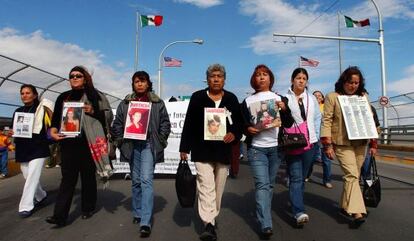Mexico takes steps to deal with growing number of femicides
Eleven municipalities in one state on alert after rash of murders involving female victims


There has been a stench of death and rampant impunity hanging over Mexico’s most-populous state for some time, and now there are statistics to prove it. According to figures released by the National Citizens Femicide Observatory (OCNF), a total of 2,318 women have been murdered in the State of Mexico over the past nine years.
The situation has become so critical that the state governor, Eruviel Ávila, took the unprecedented decision on Thursday to put 11 municipalities on special alert, to force local agencies to act swiftly to try and stop the growing number of femicides.
In 2010, it was estimated that every 20 hours a woman was killed in Ciudad Juárez
A similar initiative was put into action in the northern border city of Ciudad Juárez after a rash of murders and disappearances of women began taking place. In 2010, it was estimated that every 20 hours a woman was killed in Ciudad Juárez, which is located along the border with Texas.
Six women are killed each day in Mexico, according to the observatory. In a two-year period, from 2012 to 2013, a total of 3,892 women died in violent crimes, and between 2005 and 2010, more than 500 murder cases in which women were victims went unsolved.
In 2010, civic and pro-women’s rights organizations demanded for the first time that the Mexican government take action against femicide.
Last year, the government initiated an investigation after a court ruled in favor of a group of associations that filed a complaint. The results of the inquiry are expected to be released later this year.
In this context, Governor Ávila said that “the alert will allow us to strengthen public policy in favor of women and obtain additional resources” to be used in fighting femicide.
Welcoming Ávila’s initiative, the OCNF said such a move could lead to better investigations into these crimes as well as making the State of Mexico an example for the rest of the country.
All of Mexico’s states – with the exception of Chihuahua, where Ciudad Juárez is located – list femicide as a crime. However, the OCNF said that there are still legal stumbling blocks in 17 states that make it “difficult or impossible” to categorize these types of crimes. And in those states where femicide is distinguished from other murders, investigations and prosecutions are not carried out in an effective manner.
“There are difficulties when it comes to defining what is a femicide. Discriminatory prejudices against women exist,” says María de la Luz Estrada, the OCNF coordinator.
“When we counted more than 400 cases of underage girls who disappeared in Mexico state last year, the prosecutor’s response was that many of them leave their homes to go live with their boyfriends,” she explains.
Of the 3,892 murder cases involving females that took place between 2012 and 2013, 613 were investigated and only 1.6 percent ended in a prison term for the perpetrators.
Of the 3,892 female murder cases between 2012 and 2013, only 613 were investigated
Under the General Law to Guarantee a Life without Violence for Women, all states in Mexico are obliged to have protocols, experts and rules for prosecuting such crimes. But only seven – Colima, Federal District, Jalisco, Morelos, Oaxaca, Sinaloa and Veracruz – have drafted and introduced such regulations.
In Mexico state, the alerts have been issued in municipalities with the highest populations and where organized crime groups are most active.
“Some women take La Bestia train [a dangerous route used by Central American migrants to reach the United States], and we have found there a lot of dead women migrants who end up in mass graves,” Estrada explained. “Sometimes we don’t find an entire body – just an arm.”
Tu suscripción se está usando en otro dispositivo
¿Quieres añadir otro usuario a tu suscripción?
Si continúas leyendo en este dispositivo, no se podrá leer en el otro.
FlechaTu suscripción se está usando en otro dispositivo y solo puedes acceder a EL PAÍS desde un dispositivo a la vez.
Si quieres compartir tu cuenta, cambia tu suscripción a la modalidad Premium, así podrás añadir otro usuario. Cada uno accederá con su propia cuenta de email, lo que os permitirá personalizar vuestra experiencia en EL PAÍS.
¿Tienes una suscripción de empresa? Accede aquí para contratar más cuentas.
En el caso de no saber quién está usando tu cuenta, te recomendamos cambiar tu contraseña aquí.
Si decides continuar compartiendo tu cuenta, este mensaje se mostrará en tu dispositivo y en el de la otra persona que está usando tu cuenta de forma indefinida, afectando a tu experiencia de lectura. Puedes consultar aquí los términos y condiciones de la suscripción digital.
Archived In
Últimas noticias
How Japan is trying to avert ‘digital defeat’
From digital curfews to blocking apps: How technology experts protect their children online
Why the price of coffee has skyrocketed: from Brazilian plantations to specialty coffee houses
Confined to a Cuban hospital: When electricity is a matter of life or death
Most viewed
- Pablo Escobar’s hippos: A serious environmental problem, 40 years on
- Reinhard Genzel, Nobel laureate in physics: ‘One-minute videos will never give you the truth’
- Why we lost the habit of sleeping in two segments and how that changed our sense of time
- Charles Dubouloz, mountaineering star, retires at 36 with a farewell tour inspired by Walter Bonatti
- The Florida Keys tourist paradise is besieged by immigration agents: ‘We’ve never seen anything like this’








































